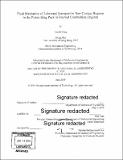Fluid mechanics of lubricant transport in non-contact regions in the piston ring pack in internal combustion engines
Author(s)
Fang, Tianshi.
Download1117710097-MIT.pdf (36.90Mb)
Other Contributors
Massachusetts Institute of Technology. Department of Mechanical Engineering.
Advisor
Tian Tian.
Terms of use
Metadata
Show full item recordAbstract
The compromise between friction and lubricant consumption has been a long-lasting challenge for the design of the piston ring pack in internal combustion engines. In order to achieve a satisfactory compromise, a systematic understanding of the lubricant transport in the piston ring pack is of critical importance. In the context of increasingly stringent standards on engine emissions, there is a more urgent need for the knowledge on the lubricant transport. This work is focused on the lubricant transport in two non-contact regions in the piston ring pack: 1) the region near a piston skirt chamfer; 2) the region near a piston third land. While the Reynolds equation has been widely employed to model the contact interfaces, more general fluid mechanics has to be applied in the non-contact regions. This thesis is the first work to comprehensively apply Computational Fluid Dynamics (CFD) and theoretical modelling to the non-contact regions in the piston ring pack. CFD was employed to fundamentally understand the lubricant transport, and theoretical models were developed to more efficiently quantify the lubricant transport. This work is a major step towards an accurate quantification of the lubricant leakage through the oil control ring (OCR) that can be critical to the lubricant consumption. The lubricant transport in a skirt chamfer region determines the pressure outside the contact interface between the lower flank of the OCR and its groove, and thus the lubricant flow rate into the OCR groove. A numerical model and a closed-form correlation were developed to efficiently predict the pressure. While the lubricant transport into the OCR groove had often been overlooked, this work revealed that this lubricant transport could be remarkable. In the region near a piston third land, two mechanisms of lubricant transport were studied: 1) high-speed bridging; 2) reattachment. Both of them introduce additional lubricant to the ring/liner contact interfaces. The effects on the inlet conditions to the ring/liner contact interfaces were quantitatively studied. The existing knowledge on high-speed bridging was enhanced in a quantitative sense. The reattachment process was first discovered and studied.
Description
Thesis: Ph. D., Massachusetts Institute of Technology, Department of Mechanical Engineering, 2019 Cataloged from PDF version of thesis. Includes bibliographical references (pages 175-177).
Date issued
2019Department
Massachusetts Institute of Technology. Department of Mechanical EngineeringPublisher
Massachusetts Institute of Technology
Keywords
Mechanical Engineering.